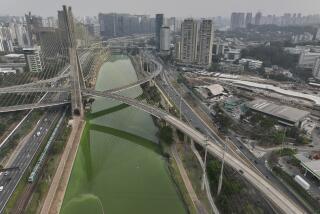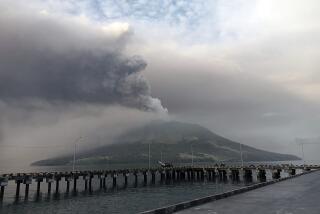Malaysia Gets Respite From Choking Haze
KUCHING, Malaysia â The people of Kuching awoke Monday to a joyous drumbeat of rain. It was so laden with pollutants that each drop seemed to hit the pavement with a thud, but for the first time in nearly a week, the air did not taste like ashes, the skies did not appear ablaze, and no one needed masks to breathe.
âWe prayed for this,â Patrick Rindia said as he prepared to reopen the driving school he owns. âI have been home for five days, watching TV with the children, sitting with wet towels against the door cracks to keep smoke out. I am tired of TV and I am tired of smoke.â
Kuching is one of the cities hardest hit by the choking smoke from bush fires raging across Indonesia. Last week, the air pollution index here reached a death-defying 839--eight times what is considered merely âunhealthyâ air. Schools closed, government offices shut down, and flights in and out of the city of 450,000 residents were canceled. Visibility was cut to about a block.
Although the heavy rains that soaked much of the country Monday may offer only a respite, Malaysians seized the moment to venture back outdoors without masks and to resume daily routines.
Malaysian Airlines, which canceled 88 domestic flights Saturday, was operating on a regular schedule. The state of emergency in Sarawak state on the island of Borneo, where Kuching is located, was declared over, and, with the pollution index falling below 100, schools, offices and businesses reopened.
Shally John was back at her stall in the farmers market and said prices were the same as always: plucked chickens, 80 cents a pound; octopus, 90 cents a pound; papaya, four for 20 cents. Cabdriver Felix Reynald picked up his first fare in a week--âKeep the windows up; the airâs still bad,â he warned--and Dr. Rabiah Abdul Ghani had time for a lunch break at the Mosque Road Health Center.
âI think the government did a good job of keeping us calm,â she said. âPeople were told what the risks were, were told to stay inside, to wear masks. We treated hundreds of people for coughs and respiratory illness. They are all right, but my worry is that 10, 20 years from now, diseases will start showing up from this haze.â Four Indonesians have died of respiratory illnesses caused by the smoke.
The âhaze,â as Malaysians euphemistically call the thick gray cloud that engulfs parts of Indonesia, Malaysia, Brunei, Thailand and the Philippines, remains a serious threat, environmentalists and doctors say, because the fires continue to burn across Sumatra and Kalimantan. Syed Babar Ali, head of the World Wide Fund for Nature, has called the results of the bush fires an âinternational catastrophe.â
Most fires were set to clear the land, either by tribesmen who for centuries have used slash-and-burn practices before planting their rice, or by large timber and plantation companies, generally run by people close to Indonesian President Suharto. The practice has led to massive deforestation here on Borneo, which is shared by Malaysia and Indonesia.
Borneo has long held a special fascination to Westerners. The island, once the domain of ruling white rajahs, is a land of triple-canopy jungle, rugged mountains and steamy swamps, still populated by orangutans. This is home to some of the worldâs last great rain forests.
That heritage is clearly threatened. Despite the arrival in Kuala Lumpur, the Malaysian capital, of elite French and Canadian firefighting units last weekend to train Malaysians in the science of battling fires, environmentalists say the only hope of containing the hundreds of blazes in Indonesia--and dissipating the hazardous haze--is in the return of monsoon rains.
Land-clearing fires have been set annually for decades but usually are extinguished by seasonal monsoons. The heavy rains, however, have grown increasingly unpredictable, and this year they havenât come at all, casting the region into drought and enabling the blazes to burrow underground, eating through layers of coal and peat.
Environmentalists blame both deforestation and unusual weather patterns created by the condition known as El Nino for the absence of monsoons. Without monsoons, they say, the fires could burn for years, and Southeast Asia could continue in the grip of hazardous haze. That would have serious health and economic implications for the region.
More to Read
Sign up for Essential California
The most important California stories and recommendations in your inbox every morning.
You may occasionally receive promotional content from the Los Angeles Times.










